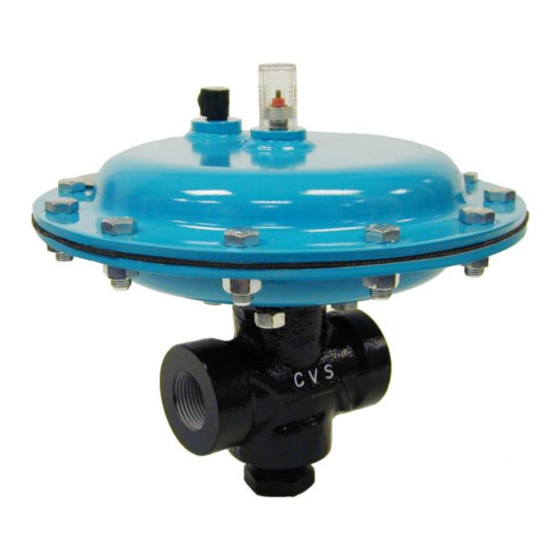CVS Controls 128PQC Series Manual de instruções - Página 6
Procurar online ou descarregar pdf Manual de instruções para Unidade de controlo CVS Controls 128PQC Series. CVS Controls 128PQC Series 12 páginas.

Changing Main Spring Range
Unless otherwise indicated, refer to Table 3 for
parts listings for replacement packing and trim
assembly, Figure 3 for packing and trim
assembly key numbers and Figure 5 for control
valve assembly key numbers.
1. Isolate off the control valve from all
pressure, and release pressure from valve
body and actuator.
2. Release pressure and drain the process
media from both sides of the valve body.
Ensure the valve is completely closed.
3. If necessary, disconnect the input signal
tubing; remove the diaphragm casing nuts
(Key 15), cap screws (Key 14) and upper
diaphragm casing (Key 1).
4. For fail-close action applications, install
main springs (Key 12), using quantities and
descriptions as outlined in Table 2.
Note: It is important to avoid loosening the
stem-nut (Key 15), as this may prevent the
valve from shutting off or from fully opening
at full pressure, and resulting in the need for
complete disassembly of the control valve to
properly install the stem and diaphragm.
5. For fail-open applications, unfasten the
locknut (Key 16), remove the flat washer
(Key 33), diaphragm (Key 35), diaphragm
plate (Key 34), spring plate (Key 2), and
main springs (Key 12).
6. Refer to Table 2 and install main springs as
indicated.
7. Reassemble the removed parts (Keys 2, 34,
35, 33, and 16). The locknut (Key 16) must
be tightened to 12 foot-pounds (16 N
8. Attach the upper diaphragm casing using
the cap screws, and casing nuts, tightening
in an even crisscross pattern to avoid
crushing the diaphragm. Tighten to 15 foot-
pounds (20 N
m).
⚫
9. Reconnect the input signal tubing to the
actuator connection of the appropriate
diaphragm casing.
6
Reversing Action or Replacing Actuator
Parts
Unless otherwise indicated, refer to Table 3 for
parts listings for replacement packing and trim
assembly, Figure 3 for packing and trim
assembly key numbers and Figure 5 for control
valve assembly key numbers.
1. Isolate the control valve from all pressure,
and release pressure from valve body and
actuator and ensure the valve is completely
closed.
2. Remove the input signal tubing, diaphragm
casing nuts (Key 15), cap screws (Key 14)
and upper diaphragm casing (Key 1).
3. Remove the following:
3.1. Main springs (Key 12)
3.2. Stem nut (Key 15)
3.3. Locknut (Key 16) and lock washer (Key
4)
3.4. Spring plate (Key 2)
3.5. Diaphragm plate (Key 34) and
diaphragm (Key 35)
3.6. Flat washer (Key 33)
4. Unscrew the four nuts (Key 32) from the
screws of the lower diaphragm casing. After
disconnecting the input signal tubing,
remove the actuator from the valve body
along with attached trim parts.
5. Remove the following:
5.1. Valve plug (Key 25)
5.2. Packing box washer (Key 27)
5.3. Slide the packing box (Key 28), O-ring
retainer (Key 18), stem O-ring (Key 19)
and the diaphragm casing O-ring (Key
31) off the stem.
6. Replace the valve stem, bottom stem nut or
m).
lock nut (Key 15 or 16) as required.
⚫
7. Refer to Figure 4 and ensure that the lower
shoulder of the bottom stem nut (Key 15)
(for fail-open assembly) or locknut (Key 16)
(for fail-close assembly) is the proper
distance from the plug end of the stem.
